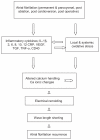Inflammatory cytokines and atrial fibrillation: current and prospective views
- PMID: 22096359
- PMCID: PMC3218735
- DOI: 10.2147/JIR.S10095
Inflammatory cytokines and atrial fibrillation: current and prospective views
Abstract
Atrial fibrillation (AF) is the most common sustained arrhythmia and a challenging clinical problem encountered in daily clinical practice. There is an increasing body of evidence linking inflammation to a broad spectrum of cardiovascular conditions including AF. Historical evidence supports an association between AF and inflammation and is consistent with the association of AF with inflammatory conditions of the heart, such as myocarditis and pericarditis. AF has been associated with myocardial oxidative stress, and antioxidant agents have demonstrated antiarrhythmic benefit in humans. Increased plasma interleukin (IL)-6, C-reactive protein (CRP), and plasma viscosity support the existence of an inflammatory state among "typical" populations with chronic AF. These indexes of inflammation are related to the prothrombotic state and may be linked to the clinical characteristics of the patients (underlying vascular disease and comorbidities), rather than simply to the presence of AF itself. It has been suggested that inflammation may have a role in the development of atrial arrhythmias after cardiac surgery, and that a genetic predisposition to develop postoperative complications exists. Cytokines can have a prognostic significance; IL-6 levels, CRP, and other cytokines may have prognostic value in AF. Cytokine lowering therapies, statins, angiotensin converting enzyme inhibitors and other anti-inflammatory agents may have a role in the treatment of AF. The present article provides an overview of the evidence linking inflammatory cytokines to AF and their therapeutic and prognostic implications.
Keywords: atrial fibrillation; cytokines; inflammation.
Figures
Similar articles
-
Relationship of interleukin-6 and C-reactive protein to the prothrombotic state in chronic atrial fibrillation.J Am Coll Cardiol. 2004 Jun 2;43(11):2075-82. doi: 10.1016/j.jacc.2003.11.062. J Am Coll Cardiol. 2004. PMID: 15172416
-
Tracing the origins of postoperative atrial fibrillation: the concept of oxidative stress-mediated myocardial injury phenomenon.Eur J Cardiovasc Prev Rehabil. 2008 Dec;15(6):735-41. doi: 10.1097/HJR.0b013e328317f38a. Eur J Cardiovasc Prev Rehabil. 2008. PMID: 19020458 Review.
-
Upstream therapies for management of atrial fibrillation: review of clinical evidence and implications for European Society of Cardiology guidelines. Part I: primary prevention.Europace. 2011 Mar;13(3):308-28. doi: 10.1093/europace/eur002. Europace. 2011. PMID: 21345926 Review.
-
Update on the association of inflammation and atrial fibrillation.J Cardiovasc Electrophysiol. 2010 Sep;21(9):1064-70. doi: 10.1111/j.1540-8167.2010.01774.x. J Cardiovasc Electrophysiol. 2010. PMID: 20455973 Review.
-
Interleukin-17A contributes to the development of post-operative atrial fibrillation by regulating inflammation and fibrosis in rats with sterile pericarditis.Int J Mol Med. 2015 Jul;36(1):83-92. doi: 10.3892/ijmm.2015.2204. Epub 2015 May 8. Int J Mol Med. 2015. PMID: 25955429 Free PMC article.
Cited by
-
COVID-19 HEART unveiling as atrial fibrillation: pathophysiology, management and future directions for research.Egypt Heart J. 2023 Apr 30;75(1):36. doi: 10.1186/s43044-023-00359-0. Egypt Heart J. 2023. PMID: 37120772 Free PMC article. Review.
-
Effectiveness of Dexamethasone in Reducing Arrhythmia in Patients Undergoing Coronary Artery Bypass Grafting.Cureus. 2024 Oct 17;16(10):e71746. doi: 10.7759/cureus.71746. eCollection 2024 Oct. Cureus. 2024. PMID: 39434929 Free PMC article.
-
Association between Inflammation and New-Onset Atrial Fibrillation in Acute Coronary Syndromes.J Clin Med. 2024 Aug 27;13(17):5088. doi: 10.3390/jcm13175088. J Clin Med. 2024. PMID: 39274304 Free PMC article. Review.
-
Beyond the beats: a systematic review of the underlying inflammatory pathways between atrial fibrillation and cognitive decline.Neurol Sci. 2025 Jul;46(7):2951-2963. doi: 10.1007/s10072-025-08040-x. Epub 2025 Feb 20. Neurol Sci. 2025. PMID: 39976882 Free PMC article.
-
Atrial Fibrillation in Patients with Septic Shock: A One-Year Observational Pilot Study.Turk J Anaesthesiol Reanim. 2019 Jun;47(3):213-219. doi: 10.5152/TJAR.2019.44789. Epub 2019 Jan 24. Turk J Anaesthesiol Reanim. 2019. PMID: 31183468 Free PMC article.
References
-
- Fuster V, Ryden LE, Asinger RW, et al. American College of Cardiology (ACC)/American Heart Association (AHA)/European Society of Cardiology (ESC) guidelines for the management of patients with atrial fibrillation: executive summary report of the ACC/AHA Task Force on practice guidelines and the ESC Committee for practice guidelines and policy conferences (committee to develop guidelines for the management of patients with atrial fibrillation) developed in collaboration with the North American Society of Pacing and Electrophysiology. Circulation. 2001;104:2118–2150. - PubMed
-
- Go AS, Hylek EM, Phillips KA, et al. Prevalence of diagnosed atrial fibrillation in adults: national implications for rhythm management and stroke prevention: the anticoagulation and risk factors in atrial fibrillation (ATRIA) study. JAMA. 2001;285:2370–2375. - PubMed
-
- Benjamin EJ, Wolf PA, D’Agostino RB, et al. Impact of atrial fibrillation on the risk of death: the Framingham Heart Study. Circulation. 1998;98:946–952. - PubMed
-
- Gronefeld GC, Lilienthal J, Kuck KH, et al. Pharmacological Intervention in Atrial Fibrillation (PIAF) Study Investigators. Impact of rate versus rhythm control on quality of life in patients with persistent atrial fibrillation: results from a prospective randomized study. Eur Heart J. 2003;24:1430–1436. - PubMed
-
- Saxena R, Lewis S, Berge E, et al. Risk of early death and recurrent stroke and effect of heparin in 3169 patients with acute ischemic stroke and atrial fibrillation in the International Stroke Trial. Stroke. 2001;32:2333–2337. - PubMed
LinkOut - more resources
Full Text Sources
Research Materials
Miscellaneous


